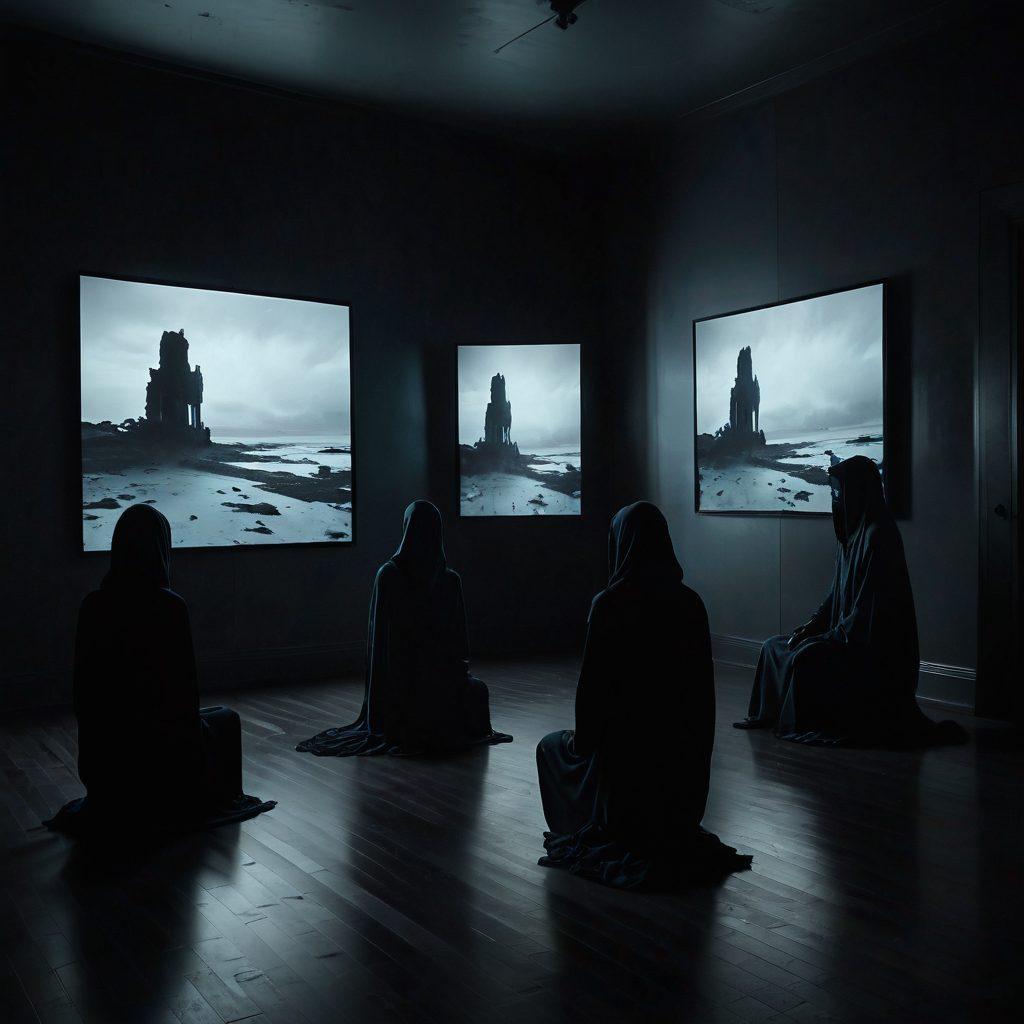Navigating the Shadows: Understanding Online Communities Amidst Sorrow and Melancholy
In a world increasingly shaped by technology, the internet has become a lifeline for those navigating the throes of sorrow and melancholy. Imagine, for a moment, someone sitting on their couch feeling downcast, their heart heavy with grief. They turn to their device, seeking connection amidst their emotional turmoil. In this digital age, online communities have emerged as safe havens for the woeful, where those who feel dejected can share their experiences and find solace. But how exactly do these virtual platforms foster connection when the weight of sorrow feels unbearable?
The emotional terrain of digital communities is complex, yet profoundly impactful. For anyone grappling with feelings of discontent or desolation, the internet offers a myriad of spaces to explore. Finding a community that resonates with your emotional state can make a world of difference. As one individual aptly stated, 'In a room full of people, I often feel alone, but in an online forum, I find a tribe that understands my grief.' Have you ever experienced that eureka moment when you realize others share your struggles?
Perhaps you’ve stumbled upon a social network dedicated to mental health issues, felt welcomed, and found yourself unearthing stories that echo your own. Within these gatherings of kindred spirits, conversations flow, allowing members to share their highs and lows, creating a tapestry woven from shared experience. The beauty of online interaction is that it breaks geographical barriers and allows connection based on emotional resonance rather than proximity. In turn, individuals find comfort and community in their most dismal moments. How powerful is that?
However, as we immerse ourselves in these online communities, we must also navigate the shadows of this realm. Can digital platforms sometimes amplify feelings of sorrow? Some users may find themselves spiraling deeper into melancholy due to the collective narratives of grief shared across the web. Alternatively, while providing support, we need to remember to take care of our emotional health too. Balance is essential in finding connection while ensuring we don’t become overwhelmed by the energy present in these digital spaces – a delicate dance if you will, don’t you agree?
Despite the challenges associated with online interaction, these communities remain vital. By leveraging tech to express the inexpressible, individuals turn sorrow into solidarity. Being part of a community that acknowledges one's feelings can be cathartic; it challenges isolation and fosters empathy. An encouraging reminder that no one has to be alone in their gloominess. As we journey through the emotional landscapes painted with sadness, let us remember: even in our darkest times, the virtual world can resonate with light, showing us that grief transforms into connection. So, as you navigate the depths of your own sorrow, look to the web; who knows, you may just find your digital anchor.
Beyond the screens and notifications, let’s remain mindful of how we communicate in these spaces. Empathy, patience, and genuine support are crucial while engaging with our fellow community members. Are we ready to embrace the healing power of online interaction in the face of anguish? By opening our hearts to those who share our stories of sorrow, we can create a network that thrives on support and understanding. This is the essence of human connection, both online and offline—the acknowledgment that our struggles, however uncanny, are part of a larger fabric woven through shared experience. Together, we can turn our grief into grace and our despondency into the strength to uplift one another, one post at a time.
The Gloomy Side of the Web: How Virtual Platforms Reflect Our Collective Melancholy
In an age where technology connects us at the tap of a finger, one could argue that the internet mirrors our innermost feelings and collective struggles. The gloomy side of the web reveals a tapestry of sorrowful stories and despondent thoughts as people navigate the complexity of their emotions. It’s fascinating, isn’t it? When we dive deep into online platforms, we often find a realm where the unhappy and woeful gather, sharing experiences that echo their grief-stricken hearts. What is it about these digital spaces that fosters communication about melancholy?
Imagine scrolling through social media, where the bright lights often mask the darker undertones of human existence. Many individuals venture into online communities seeking solace amidst sorrow, connecting with others who feel as dejected as they do. These virtual platforms become safe havens for the discontent, allowing them to articulate their feelings of sadness or loss. Have you ever shared a moment of melancholy online only to discover a wave of empathy from complete strangers? This demonstrates the powerful bond that technology can forge, despite its potential to amplify feelings of isolation.
As you engage in these communities, the stories unfold like a slow-bleeding canvas of emotions. From individuals recounting their dismal days to those seeking advice on their downcast moments, it’s evident that melancholy finds a home amidst the bytes and pixels. “We are all in the gutter, but some of us are looking at the stars,” wrote Oscar Wilde. This notion resonates on the web where even the most desolate souls latch onto the hope and understanding of shared experiences. Isn't it remarkable how our digital footprints tell tales that reflect our communal grief?
However, while these online communities serve as platforms for expressing heartfelt sorrow, they also risk entrapment within a cycle of sadness. The more time we spend in spaces that dwell on the woeful, the more dismal our outlook can become. The internet, designed for connection, can paradoxically deepen feelings of loneliness. What steps can we take to nurture healthier virtual environments that empower rather than drain us? Being mindful of the conversations we engage in and the online spaces we frequent can be transformative. We each have the power to curate a digital landscape that fosters positivity amidst our struggles.
So, whether it’s through a blog post, a tweet, or a simple reply in a forum, remember that your voice matters. In a world where melancholy is often brushed under the rug, dare to share your experiences. Forge connections that uplift and inspire. The internet can be both a tech-driven detour into despair and a pathway to healing when we choose to weave together our stories of sorrow with threads of hope. Isn’t it time we explore these communities in ways that honor our feelings while also leading us toward brighter horizons?
From Despair to Support: The Role of Online Networks in Healing Grief and Loneliness
In a world where sorrowful moments can feel overwhelmingly isolating, the internet emerges as an unexpected refuge for those grappling with grief and loneliness. Imagine this: a late-night scroll through your social media feed reveals a post that echoes your feelings of melancholy. At that moment, your heart feels a little less heavy knowing that others also share in the experience of being unhappy. This connection, facilitated by technology, transforms what might be a dismal day into a glimmer of hope—reminding us that we are never truly alone in our struggles.
Faced with the weight of sorrow, many may wonder where to find solace. The answer often lies in the virtual communities formed by those who understand us best—people who have experienced similarly woeful moments and are ready to offer their support. Whether through Facebook groups dedicated to grief, Twitter chats discussing mental health, or forums for the grief-stricken, these platforms create an extraordinary sense of understanding and camaraderie during our darkest times. Have you ever stumbled upon a digital sanctuary that instantly felt warm and welcoming?
The narratives shared within these communities are often heart-wrenching yet incredibly uplifting. One member might share their story of losing a loved one, painting a vivid picture of their feelings of despondent loss, while another might rise to offer encouraging words or personal anecdotes of healing. These digital exchanges can be life-changing, providing not just empathy, but actionable advice on how to navigate the challenging journey of grief. As I often say in these circles, "No one chooses to walk this path of sorrow, but we can choose to walk it together." Isn't that a comforting thought?
However, understanding the balance is crucial. While these online networks can uplift the downtrodden, it’s important to remember that too much time in need of distraction can lead one into a cycle of discontent. It’s easy to forget that the virtual world is merely a reflection of the real one. To truly promote healing, we must engage with both realms—seek support online, but also reach out to loved ones in the physical domain. Have you tried to feebly reach through a screen while yearning for the comfort of a friend’s embrace?
As we navigate the shadows of grief and loneliness, let us not underestimate the role of online communities. They serve as a digital lifeline, connecting those feeling doleful or downcast, reminding us that healing is a collective journey. Embrace the supportive networks that technology has to offer, and take action today: share your story, participate in discussions, and allow yourself to find strength within these solemn yet powerful spaces. Remember, every sorrow has its story, and together we can find ways to turn grief into growth, creating narratives that can spark hope in the hearts of many.


